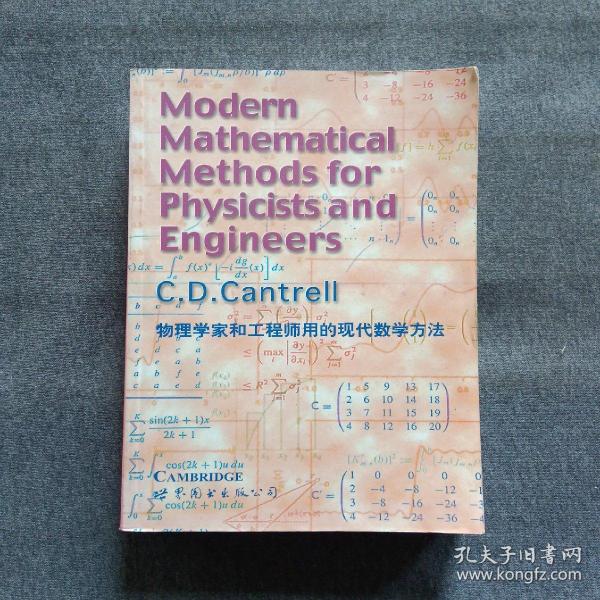物理学家和工程师用的现代数学方法(英文版)
出版时间:
2004-11
版次:
1
ISBN:
9787506266369
定价:
116.00
装帧:
平装
开本:
其他
纸张:
胶版纸
页数:
763页
-
The purpose of Modern Mathematical Methods for Physicists and Engineers is to help grad-uate and advanced undergraduate students of the physical sciences and engineering acquire a sufficient mathematical background to make intelligent use of modem computational and analytical methods. This book responds to my students' repeated requests for a mathematical methods text with a modem point of view and choice of topics.
For the past fifteen years I have taught graduate courses in computational and mathematical physics. Before introducing the course on which this book is based, I found it necessary, in courses ranging from numerical methods to the applications of group theory in physics, to summarize the rudiments of linear algebra and functional analysis before proceeding to the ostensible subjects of the course. The questions of the students who studied early drafts of this work have helped to shape the presentation. Some students working concurrently in nearby telecommunication, semiconductor, or aerospace, industries have contributed significantly to the substance of portions of the book. Preface
1 FOUNDATIONS OF COMPUTATION
1.1 Introduction
1.2 Representations of Numbers
1.2.1 Integers
1.2.2 Rational Numbers and Real Numbers
1.2.3 Representations of Numbers as Text
1.2.4 Exercises for Section 1.2
1.3 Finite Floating-point Representations
1.3.1 Simple Cases
1.3.2 Practical Floating-point Representations
1.3.3 Approaching Zero or Infinity Gracefully
1.3.4 Exercises for Section 1.3
1.4 Floating-point Computation
1.4.1 Relative Error; Machine Epsilon
1.4.2 Rounding
1.4.3 Floating-point Addition and Subtraction
1.4.4 Exercises for Section 1.4
1.5 Propagation of Errors
1.5.1 General Formulas
1.5.2 Examples of Error Propagation
1.5.3 Estimates of the Mean and Variance
1.5.4 Exercises for Section 1.5
1.6 Bibliography and Endnotes
1.6.1 Bibliography
1.6.2 Endnotes
2 SETS AND MAPPINGS
2.1 Introduction
2.2 Basic Definitions
2.2.1 Sets
2.2.2 Mappings
2.2.3 Axiom of Choice
2.2.4 Cartesian Products
2.2.5 Equivalence and Equivalence Classes
2.2.6 Exercises for Section 2.2
2.3 Union, Intersection, and Complement
2.3.1 Unions of Sets
2.3.2 Intersections of Sets
2.3.3 Relative Complement
2.3.4 De Morgan''s Laws
2.3.5 Exercises for Section 2.3
2.4 Infinite Sets
2.4.1 Basic Properties of Infinite Sets
2.4.2 Induction and Recursion
2.4.3 Countable Sets
2.4.4 Countable Unions and Intersections
2.4.5 Uncountable Sets
2.4.6 Exercises for Section 2.4
2.5 Ordered and Partially Ordered Sets
2.5.1 Partial Orderings
2.5.2 Orderings; Upper and Lower Bounds
2.5.3 Maximal Chains
2.5.4 Exercises for Section 2.5
2.6 Bibliography
3 EVALUATION OF FUNCTIONS
3.1 Introduction
3.2 Sensitivity and Condition Number
3.2.1 Definitions
3.2.2 Evaluation of Polynomials
3.2.3 Multiple Roots of Polynomials
3.2.4 Exercises for Section 3.2
3.3 Recursion and Iteration
3.3.1 Finding Roots by Bisection
3.3.2 Newton-Raphson Method
3.3.3 Evaluation of Series
3.3.4 Exercises for Section 3.3
3.4 Introduction to Numerical Integration
3.4.1 Rectangle Rules
3.4.2 Trapezoidal Rule
3.4.3 Local and Global Errors
3.4.4 Exercises for Section 3.4
3.5 Solution of Differential Equations
3.5.1 Euler''s Method
3.5.2 Truncation Error of Euler''s Method
3.5.3 Stability Analysis of Euler''s Method
3.5.4 Selected Finite-difference Methods
3.5.5 Exercises for Section 3.5
3.6 Bibliography
4 GROUPS, RINGS, AND FIELDS
4.1 Introduction
4.2 Groups
4.2.1 Axioms
4.2.2 Two-element Group
4.2.3 Orbits and Cosets
4.2.4 Cyclic Groups
4.2.5 Dihedral Groups
4.2.6 Cubic Groups
4.2.7 Continuous Groups
4.2.8 Classes of Conjugate Elements
4.2.9 Exercises for Section 4.2
4.3 Group Homomorphisms
4.3.1 Definitions and Basic Properties
4.3.2 Normal Subgroups
4.3.3 Direct Product Groups
4.3.4 Exercises for Section 4.3
4.4 *Symmetric Groups
4.4.1 Permutations
4.4.2 Cayley''s Theorem
4.4.3 Cyclic Permutations
4.4.4 Even and Odd Permutations
4.4.5 Exercises for Section 4.4
4.5 Rings and Integral Domains
4.5.1 Axioms and Examples
4.5.2 Basic Properties of Rings
4.5.3 Rational Numbers
4.5.4 *Ring Homomorphisms
4.5.5 Exercises for Section 4.5
4.6 Fields
4.6.1 Axioms and Examples
4.6.2 *Galois Fields
4.6.3 Exercises for Section 4.6
4.7 Bibliography
5 VECTOR SPACES
5.1 Introduction
5.2 Basic Definitions and Examples
5.2.1 Axioms for a Vector Space
5.2.2 Selected Realizations of the Vector-space Axioms
……
6 LINEAR MAPPINGS I
7 LINEAR FUNCTIONALS
8 INNER PRODUCTS AND NORMS
9 LINEAR MAPPINGS II
10 CONVERGENCE IN NORMED VECTOR SPACES
11 GROUP REPRESENTATIONS
12 SPECIAL FUNCTIONS
APPENDIX A INDEX OF NOTATION
APPENDIX B AFFINE MAPPINGS
APPENDIX C PSEUDO-UNITARY SPACES
APPENDIX D REMAINDER TERM
APPENDIX E BOLZANO-WEIERSTRAB THEOREM
APPENDIX F WEIERSTRAB APPROXIMATION THEOREM
Index
-
内容简介:
The purpose of Modern Mathematical Methods for Physicists and Engineers is to help grad-uate and advanced undergraduate students of the physical sciences and engineering acquire a sufficient mathematical background to make intelligent use of modem computational and analytical methods. This book responds to my students' repeated requests for a mathematical methods text with a modem point of view and choice of topics.
For the past fifteen years I have taught graduate courses in computational and mathematical physics. Before introducing the course on which this book is based, I found it necessary, in courses ranging from numerical methods to the applications of group theory in physics, to summarize the rudiments of linear algebra and functional analysis before proceeding to the ostensible subjects of the course. The questions of the students who studied early drafts of this work have helped to shape the presentation. Some students working concurrently in nearby telecommunication, semiconductor, or aerospace, industries have contributed significantly to the substance of portions of the book.
-
目录:
Preface
1 FOUNDATIONS OF COMPUTATION
1.1 Introduction
1.2 Representations of Numbers
1.2.1 Integers
1.2.2 Rational Numbers and Real Numbers
1.2.3 Representations of Numbers as Text
1.2.4 Exercises for Section 1.2
1.3 Finite Floating-point Representations
1.3.1 Simple Cases
1.3.2 Practical Floating-point Representations
1.3.3 Approaching Zero or Infinity Gracefully
1.3.4 Exercises for Section 1.3
1.4 Floating-point Computation
1.4.1 Relative Error; Machine Epsilon
1.4.2 Rounding
1.4.3 Floating-point Addition and Subtraction
1.4.4 Exercises for Section 1.4
1.5 Propagation of Errors
1.5.1 General Formulas
1.5.2 Examples of Error Propagation
1.5.3 Estimates of the Mean and Variance
1.5.4 Exercises for Section 1.5
1.6 Bibliography and Endnotes
1.6.1 Bibliography
1.6.2 Endnotes
2 SETS AND MAPPINGS
2.1 Introduction
2.2 Basic Definitions
2.2.1 Sets
2.2.2 Mappings
2.2.3 Axiom of Choice
2.2.4 Cartesian Products
2.2.5 Equivalence and Equivalence Classes
2.2.6 Exercises for Section 2.2
2.3 Union, Intersection, and Complement
2.3.1 Unions of Sets
2.3.2 Intersections of Sets
2.3.3 Relative Complement
2.3.4 De Morgan''s Laws
2.3.5 Exercises for Section 2.3
2.4 Infinite Sets
2.4.1 Basic Properties of Infinite Sets
2.4.2 Induction and Recursion
2.4.3 Countable Sets
2.4.4 Countable Unions and Intersections
2.4.5 Uncountable Sets
2.4.6 Exercises for Section 2.4
2.5 Ordered and Partially Ordered Sets
2.5.1 Partial Orderings
2.5.2 Orderings; Upper and Lower Bounds
2.5.3 Maximal Chains
2.5.4 Exercises for Section 2.5
2.6 Bibliography
3 EVALUATION OF FUNCTIONS
3.1 Introduction
3.2 Sensitivity and Condition Number
3.2.1 Definitions
3.2.2 Evaluation of Polynomials
3.2.3 Multiple Roots of Polynomials
3.2.4 Exercises for Section 3.2
3.3 Recursion and Iteration
3.3.1 Finding Roots by Bisection
3.3.2 Newton-Raphson Method
3.3.3 Evaluation of Series
3.3.4 Exercises for Section 3.3
3.4 Introduction to Numerical Integration
3.4.1 Rectangle Rules
3.4.2 Trapezoidal Rule
3.4.3 Local and Global Errors
3.4.4 Exercises for Section 3.4
3.5 Solution of Differential Equations
3.5.1 Euler''s Method
3.5.2 Truncation Error of Euler''s Method
3.5.3 Stability Analysis of Euler''s Method
3.5.4 Selected Finite-difference Methods
3.5.5 Exercises for Section 3.5
3.6 Bibliography
4 GROUPS, RINGS, AND FIELDS
4.1 Introduction
4.2 Groups
4.2.1 Axioms
4.2.2 Two-element Group
4.2.3 Orbits and Cosets
4.2.4 Cyclic Groups
4.2.5 Dihedral Groups
4.2.6 Cubic Groups
4.2.7 Continuous Groups
4.2.8 Classes of Conjugate Elements
4.2.9 Exercises for Section 4.2
4.3 Group Homomorphisms
4.3.1 Definitions and Basic Properties
4.3.2 Normal Subgroups
4.3.3 Direct Product Groups
4.3.4 Exercises for Section 4.3
4.4 *Symmetric Groups
4.4.1 Permutations
4.4.2 Cayley''s Theorem
4.4.3 Cyclic Permutations
4.4.4 Even and Odd Permutations
4.4.5 Exercises for Section 4.4
4.5 Rings and Integral Domains
4.5.1 Axioms and Examples
4.5.2 Basic Properties of Rings
4.5.3 Rational Numbers
4.5.4 *Ring Homomorphisms
4.5.5 Exercises for Section 4.5
4.6 Fields
4.6.1 Axioms and Examples
4.6.2 *Galois Fields
4.6.3 Exercises for Section 4.6
4.7 Bibliography
5 VECTOR SPACES
5.1 Introduction
5.2 Basic Definitions and Examples
5.2.1 Axioms for a Vector Space
5.2.2 Selected Realizations of the Vector-space Axioms
……
6 LINEAR MAPPINGS I
7 LINEAR FUNCTIONALS
8 INNER PRODUCTS AND NORMS
9 LINEAR MAPPINGS II
10 CONVERGENCE IN NORMED VECTOR SPACES
11 GROUP REPRESENTATIONS
12 SPECIAL FUNCTIONS
APPENDIX A INDEX OF NOTATION
APPENDIX B AFFINE MAPPINGS
APPENDIX C PSEUDO-UNITARY SPACES
APPENDIX D REMAINDER TERM
APPENDIX E BOLZANO-WEIERSTRAB THEOREM
APPENDIX F WEIERSTRAB APPROXIMATION THEOREM
Index
查看详情
-
九品
河北省保定市
平均发货13小时
成功完成率95.85%
-
九五品
江苏省南京市
平均发货16小时
成功完成率92.21%

 占位居中
占位居中







